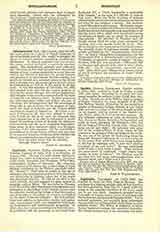

Ingolstadt, UNIVERSITY OF (1472-1800), was founded by Louis the Rich, Duke of Bavaria. The privileges of a studium generals with all four faculties had been granted by Pope Pius II, April 7, 1458, but owing to the unsettled condition of the times, could not be put into effect. Ingolstadt, modeled on the University of Vienna, had as one of its principal aims the furtherance and spread of Christian belief. For its material equipment, an unusually large endowment was provided out of the holdings of the clergy and the religious orders. The Bishop of Eichstatt, to whose diocese Ingolstadt belongs, was appointed chancellor. The formal inauguration of the university took place on June 26, 1472, and within the first semester 489 students matriculated. As in other universities prior to the sixteenth century, the faculty of philosophy comprised two sections, the Realists and the Nominalists, each under its own dean. In 1496 Duke George the Rich, son of Louis, established the Collegiurm Georgianum for poor students in the faculty of arts, and other foundations for similar purposes were subsequently made. Popes Adrian VI and Clement VII bestowed on the university additional revenues from ecclesiastical property. At the height of the humanistic movement, Ingolstadt counted among its teachers a series of remarkable savants and writers: Conrad Celtes, the first poet crowned by the German Emperor; his disciple Jacob Locher, surnamed Philomusos; Johann Turmair, known as Aventinus from his birth-place, Abensberg, editor of the “Annales Boiorum” and of the Bavarian “Chronica”, father of Bavarian history and founder (1507) of the “Sodalitas litteraria Angilostadensis”. Johannes Reuchlin, restorer of the Hebrew language and literature, was also for a time at the university.
Although Duke William IV (1508-50) and his chancellor, Leonhard von Eck, did their utmost during thirty years to keep Lutheranism out of Ingolstadt, and though the adherents of the new doctrine were obliged to retract or resign, some of the professors joined the Lutheran movement. Their influence, however, was counteracted by the tireless and successful endeavors of the foremost opponent of the Reformation, Dr. Johann Maier, better known as Eck, from the name of his birth-place, Egg, on the Gunz. He taught and labored (1510-43) to such good purpose that Ingolstadt, during the Counter-Reformation, did more than any other university for the defense of the Catholic Faith, and was for the Church in Southern Germany what Wittenberg was for Protestantism in the north. In 1549, with the approval of Paul III, Peter Canisius, Salmeron, Claude Le’ ay, and other Jesuits were appointed to professorships in theology and philosophy. About the same time a college and a boarding-school for boys were established, though they were not actually opened until 1556, when the statutes of the university were revised. In 1568 the profession of faith in accordance with the Council of Trent was required of the rector and professors. In 1688 the teaching in the faculty of philosophy passed entirely into the hands of the Jesuits.
Though the university after this change, in spite of vexations and conflicts regarding exemption from taxes and juridical autonomy, enjoyed a high degree of prosperity, its existence was frequently imperiled during the troubles of the Thirty Years’ War. But its fame as a home of learning was enhanced by men such as the theologian, Gregory of Valencia (q.v.); the controversialist, Jacob Gretser (1558-1610); the moralist, Laymann (1603-1609); the mathematician and cartographer, Philip Apian; the astronomer, Christopher Scheiner (1610-1616), who, with the helioscope invented by him, discovered the sun spots and calculated the time of the sun’s rotation; and the poet, Jacob Balde, from Ensisheim in Alsace, professor of rhetoric. Prominent among the jurists in the seventeenth century were Kaspar Manz and Christopher Berold. During the latter half of that century, and especially in the eighteenth, the courses of instruction were improved and adapted to the requirements of the age. After the founding of the Bavarian Academy of Science at Munich in 1759, an anti-ecclesiastical tendency sprang up at Ingolstadt and found an ardent supporter in Joseph Adam, Baron of Ickstatt, whom the elector had placed at the head of the university. Plans, moreover, were set on foot to have the university transferred to Munich. Shortly after the celebration of the third centenary the Society of Jesus was suppressed, but some of the ex-Jesuits retained their professorships for a while longer. A movement was inaugurated in 1772 by Adam Weishaupt, professor of canon law, with a view to securing the triumph of the rationalistic “enlightenment” in Church and State by means of the secret society of “Illuminati” (q.v.), which he founded. But this organization was suppressed in 1786 by the Elector Carl Theodore, and Weishaupt was dismissed. On November 25, 1799, the Elector Maximilian IV, later King Maximilian I, decreed that the university, which was involved in financial difficulties, should be transferred to Lands-hut; and this was done in the following May. Among its leading professors towards the close were Winter the Church historian, Schrank the naturalist, and Johann Michael Sailer, writer on moral philosophy and pedagogy, who later became Bishop of Ratisbon.
KARL HOEBER

